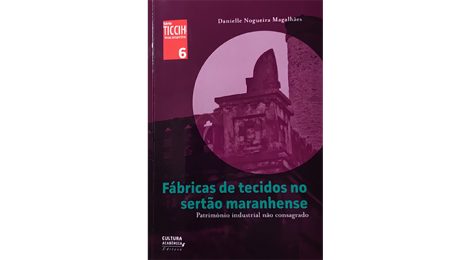
New Publication – Fábricas de tecidos no sertão maranhense
Scroll down for English translation.
 Este livro abrange uma parcela da indústria têxtil brasileira: as fábricas de tecidos implantadas no final do século XIX, no interior do Estado do Maranhão, nas cidades de Codó e Caxias, região nordeste do Brasil. Ao longo do texto são discutidos valores culturais que envolvem essas fábricas, identificados por meio de uma metodologia que abrange registro e análise da memória oral, pesquisa histórica, levantamento e análise de dados sobre técnica e tecnologia, sobre arquitetura fabril e sua relação com o espaço urbano, compondo uma paisagem industrial.
Este livro abrange uma parcela da indústria têxtil brasileira: as fábricas de tecidos implantadas no final do século XIX, no interior do Estado do Maranhão, nas cidades de Codó e Caxias, região nordeste do Brasil. Ao longo do texto são discutidos valores culturais que envolvem essas fábricas, identificados por meio de uma metodologia que abrange registro e análise da memória oral, pesquisa histórica, levantamento e análise de dados sobre técnica e tecnologia, sobre arquitetura fabril e sua relação com o espaço urbano, compondo uma paisagem industrial.
A discussão desses valores tem por propósito firmar as bases de argumentação para a necessidade de preservar e conservar os antigos complexos industriais de tecidos maranhenses, testemunhos documentais de uma das atividades industriais relevantes no início da industrialização do Brasil: a indústria têxtil algodoeira.
Em 2022, O Comitê Brasileiro para Conservação do Patrimônio Industrial abriu edital de seleção de um trabalho acadêmico que discorresse sobre conservação e preservação do patrimônio industrial no Brasil. Este livro tem origem na dissertação do Mestrado Profissional em Preservação do Patrimônio Cultural, promovido pelo Centro Lúcio Costa – CLC, escola do patrimônio vinculada ao IPHAN – Instituto do Patrimônio Histórico e Artístico Nacional, organismo federal responsável pela preservação do patrimônio cultural brasileiro. Trata-se de um trabalho de investigação que vai além dos vestígios materiais da indústria têxtil, incluindo a memória do trabalho dos antigos operários dessas fábricas.
A implantação das unidades fabris durante o século XIX tinha como prerrogativa a proximidade de nascentes ou cursos d’água, por conta da necessidade de uso abundante da água, tanto como força motriz, como na tarefa de tingir o algodão. Além disso, os rios eram as vias de transporte antes da implantação das ferrovias e construção das rodovias, tornando sua presença fator determinante para a escolha do local de implantação das indústrias. As fábricas do sertão maranhense foram implantadas às margens do rio Itapecuru, o maior rio em extensão do Estado do Maranhão, com 1.450 km. Posteriormente, junto às suas margens se instalou a Ferrovia São Luís-Teresina, em áreas consolidadas como produtoras de algodão.
As regiões onde estão localizados os municípios de Caxias e Codó eram povoações que se destacavam com plantações de algodão no século XIX, local onde surgiram as fábricas pioneiras de produção de tecidos no Maranhão. O Maranhão tem seu crescimento urbano vinculado ao enriquecimento dos comerciantes e dos habitantes com a produção de algodão e tecidos nesse período. A abundância da matéria prima e a possibilidade de transporte fluvial influenciaram a escolha do sertão maranhense para implantação de cinco fábricas de tecidos abordadas neste livro, sendo quatro delas na Cidade de Caxias: Fábrica Industrial Caxiense, Fábrica União Caxiense, Fábrica Sanharó e Fábrica Manufatora Caxiense; e uma na cidade de Codó, a Companhia Manufatureira e Agrícola do Maranhão (CMAM).
A publicação da dissertação de Danielle Nogueira Magalhães, que foi selecionada pelo Comitê Brasileiro para Conservação do Patrimônio Industrial – TICCIH Brasil, visa contribuir na difusão de pesquisas acadêmicas sobre patrimônio industrial e, com isso, ampliar a compreensão e reconhecimento de vestígios industriais relevantes que nos permitem entender a diversidade do processo de industrialização em diferentes pontos do país.
No ano de 2023, quando o trabalho foi premiado e o e-book ficou pronto, o lançamento do livro eletrônico foi realizado no Município de Codó/MA, na sede do Instituto Histórico e Geográfico que funciona na antiga Estação Ferroviária daquela cidade, onde está localizada uma das fábricas de tecidos pesquisadas. A versão digital do livro está disponível na plataforma do TICCIH – Brasil, @ticcihbrasil.
Comunicamos que no dia 20 de junho de 2025, às 17:30 horas, na ocasião da Bienal Internacional do Livro será realizado o lançamento da versão impressa do livro – FÁBRICAS DE TECIDOS NO SERTÃO MARANHENSE. Trata-se do Vol.6 da série TICCIH Novas Perspectivas, cuja versão digital encontra-se disponível em: https://ticcihbrasil.org.br/
Sobre a autora:
Graduada em Arquitetura e Urbanismo pela Universidade Estadual do Maranhão em 2002, mestre em Preservação do Patrimônio Cultural, Danielle Magalhães atua desde 2010 como arquiteta do Instituto do Patrimônio Histórico e Artístico Nacional. Dedicou-se aos trabalhos na Superintendência do IPHAN no Estado do Maranhão até junho de 2023. Atualmente, lotada no IPHAN do Estado do Rio de Janeiro, desenvolve ações voltadas para a preservação do patrimônio ferroviário brasileiro, entre outras atividades.
This book covers a portion of the Brazilian textile industry: the textile factories established in the late 19th century in the interior of the state of Maranhão, in the cities of Codó and Caxias, in the northeast region of Brazil. Throughout the text, cultural values involving these factories are discussed, identified through a methodology that includes recording and analyzing oral memory, historical research, survey and analysis of data on techniques and technology, factory architecture and its relationship with the urban space, composing an industrial landscape.
The discussion of these values aims to establish the basis for arguing for the need to preserve and conserve the old textile industrial complexes of Maranhão, documentary evidence of one of the relevant industrial activities at the beginning of Brazil’s industrialization: the cotton textile industry.
In 2022, the Brazilian Committee for the Conservation of Industrial Heritage opened a call for submissions for an academic paper that discussed the conservation and preservation of industrial heritage in Brazil. This book originated from the dissertation for the Professional Master’s Degree in Preservation of Cultural Heritage, promoted by the Lúcio Costa Center – CLC, a heritage school linked to IPHAN – National Institute of Historical and Artistic Heritage, a federal agency responsible for the preservation of Brazilian cultural heritage. This is a research work that goes beyond the material remains of the textile industry, including the memory of the work of former workers in these factories.
The establishment of factories during the 19th century was prerequisite for being close to springs or watercourses, due to the need for abundant use of water, both as a driving force and in the task of dyeing cotton. Furthermore, rivers were the transport routes before the construction of railways and highways, making their presence a determining factor in choosing the location for the establishment of industries. The factories in the backlands of Maranhão were established on the banks of the Itapecuru River, the longest river in the state of Maranhão, at 1450 km. Later, the São Luís-Teresina Railway was installed along its banks, in areas that were consolidated as cotton producers.
The regions where the municipalities of Caxias and Codó are located nearby cotton plantations in the 19th century, and were the place where the pioneering textile factories in Maranhão emerged. The urban growth of Maranhão was linked to the enrichment of merchants and residents through the production of cotton and textiles during this period. The abundance of raw materials and the possibility of river transportation influenced the choice of the backlands of Maranhão as the location for the establishment of five textile factories discussed in this book, four of which were in the city of Caxias: (1)Fábrica Industrial Caxiense, (2)Fábrica União Caxiense, (3)Fábrica Sanharó and (4)Fábrica Manufatora Caxiense; and one in the city of Codó, (5)Companhia Manufatureira e Agrícola do Maranhão (CMAM).
The publication of Danielle Nogueira Magalhães’ dissertation, which was selected by the Brazilian Committee for the Conservation of Industrial Heritage – TICCIH Brazil, aims to contribute to the dissemination of academic research on industrial heritage and, with this, expand the understanding and recognition of relevant industrial remains that allow us to understand the diversity of the industrialization process in different parts of the country.
In 2023, when the work was awarded and the e-book was ready, the e-book was released in the city of Codó/MA, at the headquarters of the Historical and Geographical Institute, which operates in the old train station of that city, where one of the textile factories studied is located. The digital version of the book is available on the TICCIH – Brazil platform, @ticcihbrasil.
We are very pleased to inform you that on June 20th, 2025, at 5:30 p.m., during the International Book Biennial, will be release the printed version of the book – FABRICS IN THE SERTÃO MARANHENSE. This is Vol.6 of the TICCIH New Perspectives series, the digital version of which is available at: https://ticcihbrasil.org.br/
About the author:
Graduated in Architecture and Urbanism from the State University of Maranhão in 2002, with a master’s degree in Preservation of Cultural Heritage, Danielle Magalhães has been working as an architect at the National Institute of Historical and Artistic Heritage since 2010. She dedicated herself to work at the IPHAN Superintendence in the State of Maranhão until June 2023. Currently assigned to IPHAN in the State of Rio de Janeiro, she develops actions aimed at the preservation of Brazilian railway heritage, among other activities.

